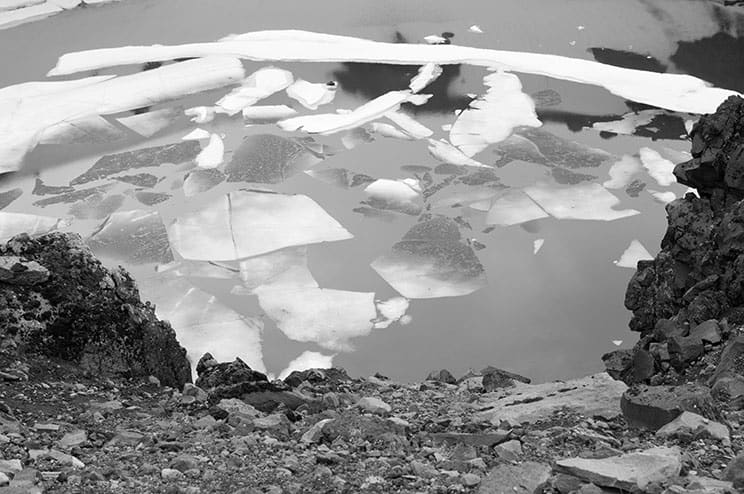From November 11 to December 6, 2019, Living Among Alaska’s Volcanoes; My Kind of Wilderness, an exhibition by Gary Freeburg, will be on view at Mary Baldwin’s Hunt Gallery.

Freeburg was born 1948 in Minneapolis, Minnesota, and was raised there. After serving in Vietnam in the U.S. Navy, Freeburg received three degrees in photography: his BFA and MA from Minnesota State University at Mankato in 1974 and 1977, and his MFA from the University of Iowa in 1978. He lived and worked in Alaska for 25 years and served as professor of art at the University of Alaska’s Kenai Peninsula College, where he directed the art program and served as curator in the campus art gallery that now bears his name. He is also an emeritus professor of art and past director of the Duke Hall Gallery of Fine Art at James Madison University.
Freeburg has worked with renowned photographers and educators, such as Ansel Adams, Oliver Gagliani, and John Schultze. His photographs have been exhibited nationally and appeared in Under Northern Lights, Writers and Artists View the Alaskan Landscape and Looking North (University of Washington Press, 1998; 2000).
He has received an Individual Artist Fellowship Grant from the Alaska State Council on the Arts, Anchorage; an honorary degree for his contribution to the visual arts from Alaska Pacific University, Anchorage; and an Art Educator of the Year Award in Higher Education from the Alaska Art Education Association. He was recognized by the Getty Center for Education in the Arts for his art advocacy work in Alaska and Washington, DC. The documentary film by George C. Johnson, An Artist’s Journey to the Valley of Ten Thousand Smokes: The Photography of Gary Freeburg, serves as a capstone to Freeburg’s photographic work in the wilderness of Alaska.
A portion of Freeburg’s artist’s statement follows:
Much of what I have learned in my life I have absorbed by physically undertaking the task at hand. By getting my fingers into everything I could, I have found pleasure and understanding in the good and not so good of living. I believe I have held nearly every job imaginable from assistant manager at a pizza joint to digging ditches for the gas company, to climbing telephone poles as a lineman for a regional phone company, to working in the oil patch as a roustabout on a drill barge in the Gulf of Mexico. Add to that six years in the U.S. Navy of which two (1971–73) were spent off the coast of Vietnam and several part-time seasonal jobs including long-line halibut fishing in the Gulf of Alaska and my resume is nearly complete.
The dry gardens of Japan coupled with the influences I mentioned earlier have taken me to the volcanoes on the Alaska Peninsula. I wanted the experience of the dry gardens but I wanted that experience in a place that was not man made. The Valley of 10,000 Smokes in Katmai National Park and Preserve and the wonderful crater and environment of Aniakchak National Monument are two areas that I have explored on eight separate expeditions. These volcanic places have placed me in the center of a post-eruption, primitive landscape free of distraction where rock features surrounded by sands that are comprised of pumice and ash reflect what I have experienced in Zen dry gardens.
The white sand in the dry gardens of Japan is raked and may change direction from one day to the next while the stones remain in the same position creating a feeling of stability in an ever-changing environment. In the volcanic environment, the igneous stones rest on the surface or emerge from beneath the surface of a weldment of pumice and ash that is constantly shifting because of wind and water erosion. Again, the volcanic stones remain in place while the sands change direction and the parallel is drawn between the volcanic places on the Alaska Peninsula and the dry gardens of Japan. The difference between the two places is one of observation and inclusion. The dry garden is meant to be experienced from the outside where the volcanic plains are meant to be experienced from the inside; to be surrounded by and to be a part of the environment. In both instances, the connection to the natural world and personal thought is powerful.
My photographs, drawings, and writings have recorded my thinking at the point in time that I created them. I now look at my images and writings for the truth to be revealed about myself, as well as what I saw reflected in the world of Alaska’s volcanic wilderness.
Read Freeburg’s full artist’s statement here.
A reception will be held for the artist from 4:30 to 6 p.m. on November 11 in Hunt Gallery. The public is invited to attend.
Hunt Gallery is dedicated to the exhibition of contemporary work in all media by regionally and nationally recognized artists. The gallery is open 9 a.m. to 5 p.m. Monday through Friday during the academic year. Hunt Gallery’s schedule for the 2019–20 academic year can be found online.